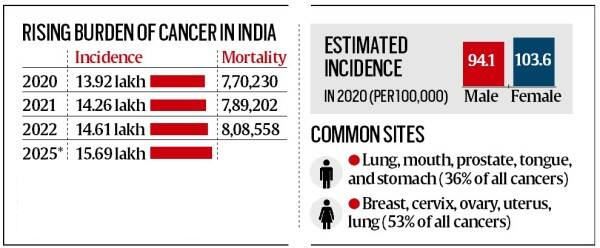India’s First Comprehensive Cancer Multi-Omics Data Portal | 28 Sep 2024
Why in News?
Recently, the Indian Cancer Genome Atlas (ICGA) has launched India’s first comprehensive cancer multi-omics data portal as a repository for the country’s cancer genomics.
- This will provide open access to clinically correlated data from Indian cancer patients.
Indian Cancer Genome Atlas (ICGA)
- It is a national initiative mapping cancer genomics, transcriptomics, and proteomics in India, operating as a not-for-profit organisation supported by public, private, and philanthropic collaboration.
- It engages over 50 clinicians, researchers, and data analysts to enhance cancer diagnosis and treatment in India while contributing to the global understanding of cancer biology.
What are the Key Features of Comprehensive Cancer Multi-omics Data Portal?
- Objective:
- The goal is to create Indian-specific cancer datasets to enable personalised cancer treatment protocols tailored to Indian populations, addressing molecular-level differences between Indian and Western cancer patients.
- Key Features of the Portal:
- Multi-Omics Data: It provides genomic, transcriptomic, and proteomic data for breast cancer, starting with 50 patients and plans to expand to over 500.
- It will offer data that includes Deoxyribonucleic Acid (DNA), Ribonucleic Acid (RNA), and protein profiles of breast cancer patients, integrated with clinical outcomes.
- Later, the dataset will be expanded to lung cancer patients and other cancers as well.
- cBioPortal Integration: It is built on the internationally recognised cBioPortal platform facilitating seamless integration with global cancer research efforts.
- It also invites researchers worldwide to contribute and expand the platform, fostering collaborative cancer research.
- Free Access: It offers ethical data-sharing practices under Biotech-PRIDE (Promotion of Research and Innovation through Data Exchange) guidelines, promoting collaboration within the scientific community.
- Multi-Omics Data: It provides genomic, transcriptomic, and proteomic data for breast cancer, starting with 50 patients and plans to expand to over 500.
Multi-omics
- Multi-omics is a holistic approach to biology that combines data from multiple "omics" fields to gain a more comprehensive understanding of biological processes.
- These fields include:
- Genomics: Study of the complete set of DNA (including all of its genes).
- Transcriptomics: Study of a complete set of RNA molecules expressed in a cell, tissue, or organism.
- Epigenomics: Study of epigenetic changes, or changes in gene expression that don't alter the DNA sequence
- Proteomics: Study of the interactions, function, composition, and structures of proteins and their cellular activities
State of Cancer Burden in India
- Globally, in 2022, there were an estimated 20 million new cancer cases and 9.7 million deaths.
- In 2022, India recorded 1,413,316 new cancer cases, with a slight majority of female patients.
- Breast cancer was the most prevalent, representing 13.6% of all cases and over 26% among women.
- Other significant cancers included lip and oral cavity cancers, cervical and uterine cancers, lung cancer, and esophageal cancers.
Read More: Rising Cancer Concerns.
UPSC Civil Services Examination, Previous Year Question (PYQ)
Q1. ‘Mission Indradhanush’ launched by the Government of India pertains to (2016)
(a) Immunization of children and pregnant women
(b) Construction of smart cities across the country
(c) India’s own search for the Earth-like planets in outer space
(d) New Educational Policy
Ans: (a)
Q. With reference to the treatment of cancerous tumours, a tool called cyberknife has been making the news. In this context, which one of the following statements is not correct? (2010)
(a) It is a robotic image guided system
(b) It delivers an extremely precise dose of radiation
(c) It has the capability of achieving sub-millimetre accuracy
(d) It can map the spread of tumour in the body
Ans: (d)
Q. ‘RNA interference (RNAi)’ technology has gained popularity in the last few years. Why? (2019)
- It is used in developing gene-silencing therapies.
- It can be used in developing therapies for the treatment of cancer.
- It can be used to develop hormone replacement therapies.
- It can be used to produce crop plants that are resistant to viral pathogens.
Select the correct answer using the code given below.
(a) 1, 2 and 4
(b) 2 and 3
(c) 1 and 3
(d) 1 and 4 only
Ans: (a)

